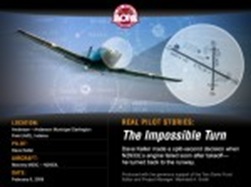Every pilot has been told that attempting to return to the airport after experiencing an engine failure right after take-off is a bad idea. After all, conventional wisdom tells pilots to avoid as much maneuvering as possible and to find a suitable place to land that is ahead and not behind the aircraft. However, just how impossible is the “impossible” turn and are there situations where it can be safely pulled off?
As Bruce Landsberg, the President of the AOPA Air Safety Foundation, recently noted on the AOPA blog:
We have ample evidence that a poorly executed turn or an attempt at too low an altitude is disastrous. What we don’t know is how many people successfully pulled it off because there are no statistics on the positive side. Sorry, but local hangar flying does not quite qualify as a reliable source even as the story gets better with each retelling!
Bruce then noted a new “Real Pilot Story” entitled The Impossible Turn which covers an incident involving a Mooney that managed to perform the impossible turn and it was all captured on video.
Hence, what do you think about the possibility of doing the “impossible” turn and have you ever heard of an instance where it was successfully performed? Are there any circumstances or a particular aircraft where you feel that the impossible turn is possibly worth attempting?

The operative words are "poorly executed" and "at too low an altitude". At the right altitude and properly executed, it may be a better alternative, especially in highly congested terrain. Learning how to execute, the right altitude, and practice are critical. It shouldn't be attempted on the strength of reading an article, blog, or listening to hanger talk; I'd hope that all of the above might inspire a desire to seek out competent instruction. Finding competent instruction is probably a challenge. My objection to the Real Pilot Story is that it probably discourages people from making the attempt.
There was an interesting article on this that I read ages ago. I should have bookmarked it. It was about the psychological effects on the pilot flying close to the ground (it looks so fast!) and why someone with experience on a cropduster would probably make the turn when a "normal" pilot wouldn't.
…I wish I could find it, I don't remember the details.
Glider flight instruction regularly includes practicing 180 deg turns and downwind landings from altitudes above ~200' AGL. The exercise simulates a rope break or towplane engine failure early in the flight. All students must learn this as part of ordinary pre-solo training. If the rope breaks below this altitude, the general rule is the landing should be straight ahead or up to 90 deg turn only.